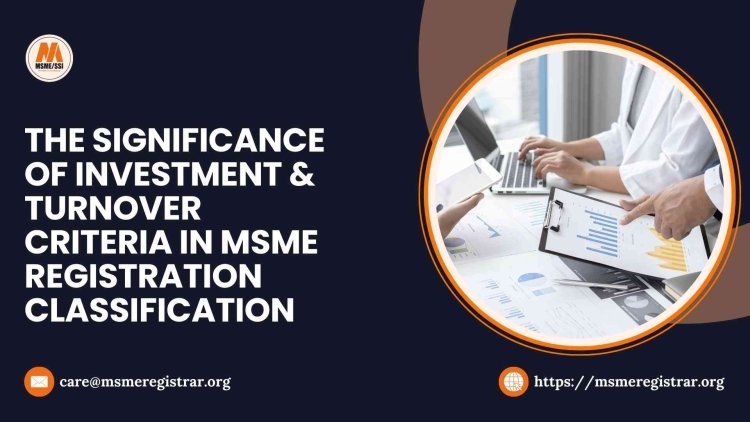The Significance of Investment & Turnover Criteria in MSME Registration Classification
Micro, Small, and Medium Enterprises (MSME) are pivotal to India's economic landscape, contributing significantly to employment, industrial output, and exports.

Micro, Small, and Medium Enterprises (MSME) are pivotal to India's economic landscape, contributing significantly to employment, industrial output, and exports. The classification of these enterprises, primarily based on investment and turnover criteria, plays a crucial role in determining the support and incentives they receive from the government. The Union Budget 2025-26 introduced notable revisions to these criteria, aiming to foster growth and competitiveness within the MSME sector.
Understanding MSME Registration Classification
Traditionally, MSME Registration in India have been categorized based on their investment in plant and machinery or equipment and their annual turnover. This classification ensures that enterprises receive tailored benefits, such as priority sector lending, tax exemptions, and subsidies, appropriate to their scale and needs.
Revisions in the 2025 Budget
In the Union Budget 2025-26, Finance Minister Nirmala Sitharaman announced significant enhancements to the investment and turnover limits for MSME Registration classification. The investment limits have been increased by 2.5 times, and the turnover limits have been doubled across all categories. The revised criteria are as follows:
Micro Enterprises: Investment limit increased from ₹1 crore to ₹2.5 crore; turnover limit from ₹5 crore to ₹10 crore.
Small Enterprises: Investment limit raised from ₹10 crore to ₹25 crore; turnover limit from ₹50 crore to ₹100 crore.
Medium Enterprises: Investment limit elevated from ₹50 crore to ₹125 crore; turnover limit from ₹250 crore to ₹500 crore.
These adjustments aim to help MSME Registrations achieve higher efficiencies of scale, technological upgradation, and better access to capital.
Why Investment and Turnover Criteria Matter for MSME Registrations
The investment and turnover criteria are critical in shaping MSME Registration policies and benefits. The revised classification criteria address several key areas that impact business sustainability and competitiveness.
1. Expanding MSME Registration Eligibility for Government Schemes
The classification determines which enterprises qualify for government support programs such as:
Credit Guarantee Scheme (CGTMSE): Offers collateral-free loans to MSME Registrations. The 2025 budget increased the guarantee coverage from ₹5 crore to ₹10 crore.
Subsidies for Technology Upgradation: Higher investment limits allow MSME Registrations to upgrade their machinery without fear of losing government incentives.
Priority Sector Lending (PSL): MSME Registrations enjoy easier access to loans at lower interest rates under the PSL category.
2. Encouraging Growth Without Classification Loss
Previously, MSME Registrations had to restrict their investment and turnover to retain their classification benefits. The revised limits ensure that businesses can scale up without reclassification issues.
For example, a small enterprise nearing the ₹50 crore turnover limit earlier faced the risk of losing MSME Registration status. Now, with the turnover limit raised to ₹100 crore, businesses can expand without losing financial incentives.
3. Enhancing Credit Access and Financial Inclusion
The budget’s revision of MSME Registration classification allows businesses to access more substantial credit facilities. The increase in credit guarantee coverage and the revised investment thresholds make MSME Registrations more attractive to banks and NBFCs, reducing collateral requirements.
Impact on MSME Registration Credit Flow:
- More businesses qualify for collateral-free loans.
- Banks and NBFCs find MSME Registration lending more profitable and less risky.
- MSME Registrations can secure higher-value loans for business expansion.
4. Promoting MSME Registration Formalization and Digital Adoption
The enhanced classification criteria encourage informal and small-scale enterprises to register under Udyam to avail of benefits. This leads to:
- Higher tax compliance and increased government revenue.
- Greater access to formal financing instead of relying on private lenders.
- Increased adoption of digital payments and online business transactions.
The government’s push for Digital India and MSME Registration formalization aligns with these classification changes, making MSME Registrations more competitive.
5. Supporting Export Competitiveness & Market Expansion
With a higher turnover threshold, more businesses can now engage in exports without outgrowing their MSME Registration status. The 2025 budget also introduced:
- Increased incentives under the Export Promotion Capital Goods (EPCG) scheme for medium enterprises.
- Reduced import duties on raw materials used by MSME Registrations, making manufacturing more competitive.
- Simplified compliance norms for export-oriented MSME Registrations.
6. Addressing Inflation and Economic Growth
The previous MSME Registration classification limits were set in 2020 and did not account for inflation and rising operational costs. The 2025 budget adjusts investment and turnover thresholds to reflect:
- Rising costs of machinery and technology.
- Increased revenue streams due to digitization and global markets.
- Post-pandemic economic recovery trends.
This ensures that businesses remain within their classification despite inflation-driven revenue increases.
Future Outlook: How the MSME Registration Sector Will Benefit Post-2025
The revised classification is expected to bring several long-term benefits, such as:
- Increased domestic and international investment in MSME Registrations.
- Greater financial security and credit flow for small businesses.
- Boosted innovation and technology adoption in medium enterprises.
- Enhanced job creation and employment stability in the sector.
- Higher MSME Registration contribution to India's GDP growth.
With India aiming for a $5 trillion economy, empowering MSME Registrations through flexible classification and financial support will play a crucial role.
Note: Apply for Print Udyam Certificate through the official portal.
Conclusion
The updated MSME Registration classification criteria, as announced in the Union Budget 2025-26, mark a significant step towards enhancing business growth, financial inclusion, and economic resilience. By increasing the investment and turnover limits, the government ensures that MSME Registrations can expand without losing their classification benefits.
However, successful implementation will require strong awareness programs, streamlined compliance processes, and efficient monitoring mechanisms. As the revised criteria take effect, MSME Registrations must proactively leverage these new thresholds to drive innovation, market expansion, and financial stability.
Ultimately, these strategic reforms will strengthen India’s MSME Registration sector, fostering sustainable economic development and positioning the country as a global leader in entrepreneurship and industrial growth.
What's Your Reaction?
















